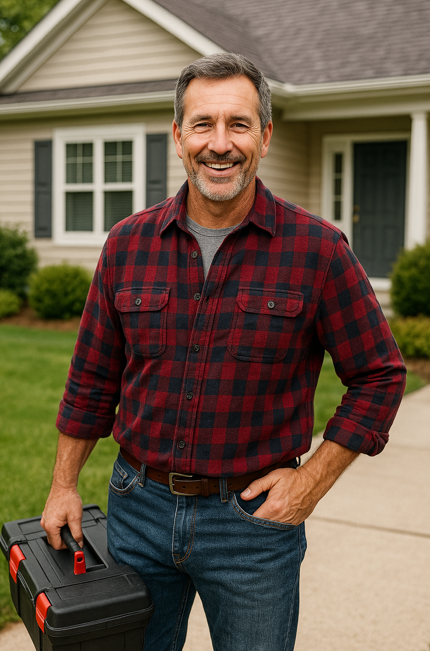Hey folks — Mike back with another deep-dive into a super-practical topic: how to properly install a 50–60 gallon electric water heater.
Look, I know this can feel intimidating at first.
There’s electrical work.
There’s plumbing.
And then there’s making sure you don’t create a flood or trip your breakers in the process.
But I promise — with a good plan, the right tools, and a solid understanding of what’s involved — you can do this safely and successfully.
So, let’s roll up our sleeves and jump in.
📍 Step 1 — Choose the Right Location
First things first — placement matters.
Your water heater should sit on a flat, level surface in an accessible, well-ventilated area with a drain nearby.
And most important? It must comply with local codes and the manufacturer’s instructions.
That often means setting the water heater up on a drain pan and making sure there’s at least 12–18 inches of clearance for servicing.
Have questions about local requirements?
Your city or county building department usually spells them out — or you can check a great overview on water heater safety at the U.S. Department of Energy at energy.gov.
⚡ Step 2 — Prep the Power: Breaker, Wire, and Disconnect
Next up — the electrical work.
Your new water heater will require a dedicated 30-amp double-pole 240-volt circuit.
✅ Run 10/2 or 10/3 wire from the water heater up to your main panel — depending on the unit’s specs.
✅ Install a proper disconnect switch near the water heater — safety first!
If you’re not comfortable running electrical, this is one part where it really pays to call a pro — and for good reason.
The Consumer Product Safety Commission lays out electrical safety guidelines at cpsc.gov — definitely worth a read.
And remember — before you touch anything electrical?
Cut power at the main breaker.
Test it with a volt meter to be sure the wires are dead. Safety matters!
💧 Step 3 — Plumbing Connections: Hot and Cold Lines
Time for some plumbing — this is where most people feel most at home.
✅ Cold water in? Connect the water supply to the cold-water inlet marked blue.
✅ Hot water out? Connect to the hot-water outlet marked red.
✅ Use Teflon tape or pipe dope on all threaded connections.
Flexible connectors can make this a lot easier — they reduce stress on the tank nipples and simplify future maintenance.
And don’t forget the T&P valve.
That’s the Temperature & Pressure Relief valve, and it needs to discharge into a drain or a safe outdoor location.
More on that from the ENERGY STAR program — see their water-heating basics at energystar.gov.
🔧 Step 4 — Fill the Tank and Check for Leaks
Before you wire anything up, fill the tank with water.
Here’s what to do:
-
Open the cold-water supply valve slowly.
-
Open a hot-water faucet in your home to bleed air.
-
Let water flow until it’s smooth — then shut off the faucet.
-
Check all your pipe connections carefully for any sign of leaks.
If you see water weeping around a fitting?
Tighten up or reapply tape as needed.
And hey — don’t skip this leak check.
Water damage can get expensive fast — especially if it goes unnoticed for a few days!
🧠 Step 5 — Wire the Unit and Power It Up
Once your tank is full and dry on the outside — it’s time to connect the wires.
✅ Remove the access cover and feed the wires through a cable connector.
✅ Match colors — usually black to black, white to white — and ground to green.
✅ Double-check your connections before closing the cover.
And one more thing — don’t forget to set the thermostat before you fire it up.
The recommended temp is 120°F — hot enough to kill bacteria but not so hot that it wastes energy or risks scalding.
The EPA’s WaterSense program discusses safe temperature settings at epa.gov.
Flip on the breaker — wait for the water to heat — then check a faucet after an hour or two.
That’s it — you’re up and running!
🧪 Step 6 — Test Safety Devices
Your water heater comes with built-in safety features — let’s make sure they’re working.
✅ T&P valve test — flip the lever and make sure water releases into the drain.
✅ Circuit breaker — trip and reset it to ensure power disconnects properly.
That might sound overly cautious — but believe me, you’ll sleep better knowing these things work.
🧠 Pro Tips for a Hassle-Free Installation
Here are a few extra pro pointers to make this easier:
🔥 Insulate your hot water pipes — it reduces heat loss.
🔥 Consider a drain pan alarm — some models will beep or text you if water is detected.
🔥 Get a thermal-expansion tank if you’re on a closed water system — most codes require it.
And check the water pressure — it should be under 80 PSI.
High pressure shortens water-heater life and could trip your T&P valve often.
🎯 Wrap-Up — Installing With Confidence
Installing a 50–60 gallon electric water heater doesn’t have to be overwhelming.
Break it into steps — placement, plumbing, wiring, filling, testing — and take your time.
And if at any point you feel unsure?
That’s when calling in a licensed pro is the smart play.
Your safety and your home’s safety are the most important parts of any project.
Here’s to a successful install — and years of dependable hot water for you and your family.
🧰Stay smart, stay comfortable, and I’ll catch you next time! - Mike🧰







